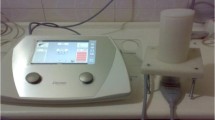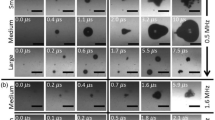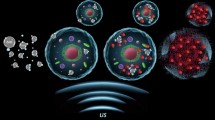Abstract
Purpose
To evaluate in vitro the feasibility of therapeutic high-intensity-focused ultrasound (HIFU) combined with microbubbles and titanium dioxide (TiO2).
Methods
Oral squamous cell carcinoma cells (HSC-2) were sonicated using a HIFU transducer with a resonant frequency of 3.5 MHz, 30 mm in diameter, and focal length of 50 mm. The ultrasound intensity was 210 W/cm2, and two pulses (0.5 s each) were sonicated for each cell sample (9 × 104 cells per well). Immediately after HIFU, the viable cells were measured by an automated cell counter. The survival rate was measured in the presence of microbubbles (Sonazoid) and peroxo titania-silica (R-P-TS) or anatase titania-silica (R-A-TS) TiO2.
Results
Cell viability immediately following sonication in the presence of TiO2 (R-A-TS) and TiO2 (R-P-TS) was 65.5 ± 0.7 and 59.4 ± 3.3 %, respectively. A marked decrease in cell viability was seen when microbubbles were added to the above cell conditions. Specifically, cell viability decreased to 14.0 ± 0.1 and 4.4 ± 0.9 % when microbubbles were added to samples containing TiO2 (R-A-TS) and TiO2 (R-P-TS), respectively.
Conclusion
Immediate in vitro cell killing was observed with short pulsed duration HIFU sonication with a combination of microbubbles and TiO2. This finding suggests that TiO2 could have caused enhanced mechanical cell destruction by microbubbles.






Similar content being viewed by others
References
Ogino C, Shibata N, Sasaki R, et al. Construction of protein-modified TiO2 nanoparticles for use with ultrasound irradiation in a novel cell injuring method. Bioorg Med Chem Lett. 2010;20:5320–5.
Harada Y, Ogawa K, Irei Y, et al. Ultrasound activation of TiO2 in melanoma tumors. J Control Release. 2011;149:190–5.
Tachibana K, Tachibana S. Albumin microbubble echo-contrast material as an enhancer for ultrasound accelerated thrombolysis. Circulation. 1995;92:1148–50.
Ohl CD, Arora M, Ikink R, et al. Sonoporation from jetting cavitation bubbles. Biophys J. 2006;91:4285–95.
Abe N, Nakamoto H, Suzuki T, et al. Ex vivo evaluation of high-intensity focused ultrasound with ultrasonic-induced cavitation bubbles. J Med Ultrasonics. 2014;41:3–9.
Wu J. Shear stress in cells generated by ultrasound. Prog Biophys Mol Biol. 2007;93:363–73.
Nejad SM, Hosseini SHR, Akiyama H, et al. Optical observation of cell sonoporation with low intensity ultrasound. Biochem Biophys Res Commun. 2011;413:218–23.
Esquivel K, Arriaga L, Rodríguez F, et al. Development of a TiO2 modified optical fiber electrode and its incorporation into a photoelectrochemical reactor for wastewater treatment. Water Res. 2009;43:3593–603.
Tsuang YH, Wu J, Zhang Z, et al. Studies of photokilling of bacteria using titanium dioxide nanoparticles. Artif Organs. 2008;32:167–74.
Cheng CL, Sun D, Chu W, et al. The effects of the bacterial interaction with visible-light responsive titania photocatalyst on the bactericidal performance. J Biomed Sci. 2009;16:7.
Zubkov T, Stahl D, Thompson TL, et al. Ultraviolet light-induced hydrophilicity effect on TiO2(110)(1 × 1). Dominant role of the photooxidation of adsorbed hydrocarbons causing wetting by water droplets. J Phys Chem B. 2005;109:15454–62.
Wang J, Go Y, Liu B, et al. Detection and analysis of reactive oxygen species (ROS) generated by nano-sized TiO2 powder under ultrasonic irradiation and application in sonocatalytic degradation of organic dyes. Ultrason Sonochem. 2011;18:177–83.
Shimizu N, Ogino C, Derider MF, et al. Sonocatalytic facilitation of hydroxyl radical generation in the presence of TiO2. Ultrason Sonochem. 2008;15:988–94.
Chihara Y, Fujimoto K, Konod M, et al. Anti-tumor effects of liposome-encapsulated titanium dioxide in nude mice. Pathobiology. 2007;740:353–8.
Zhu YL, Eaton JW, Li C. Titanium Dioxide (TiO2) nanoparticles preferentially induce cell death in transformed cells in a Bak/Bax-independent fashion. PLoS One. 2012;7:e50607.
Acknowledgments
This study was supported in part by the Japanese Society of Ultrasound in Medicine 2013 Research Grant.
Conflict of interest
Katsuro Tachibana, Hitomi Endo, Loreto Feril, Seyedeh Moosavi Nejad, Hiromasa Takahashi, Kyoichi Narihira, and Toshihiro Kikuta all declare that they have no conflict of interest.
Ethical standard
This article does not contain any experiments with human or animal subjects performed by any of the authors.
Author information
Authors and Affiliations
Corresponding author
About this article
Cite this article
Tachibana, K., Endo, H., Feril, L.B. et al. Enhanced mechanical damage to in vitro cancer cells by high-intensity-focused ultrasound in the presence of microbubbles and titanium dioxide. J Med Ultrasonics 42, 449–455 (2015). https://doi.org/10.1007/s10396-015-0626-4
Received:
Accepted:
Published:
Issue Date:
DOI: https://doi.org/10.1007/s10396-015-0626-4




